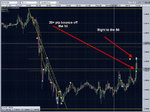barjon
Legendary member
- Messages
- 10,752
- Likes
- 1,863
Hi everyone,
As a new boy to T2W can I ask if anyone makes much use of Fibonacci retracement levels?
I have found that candlestick reversal indicators occuring at 50% retracement level are very reliable, about 65%, although not necessarily to the degree that gives a significantly profitable trade.
Sufficient though for me to double my normal trading size when a swing high (low) is associated with a candlestick reversal indicator at around the 50% retracement level.
I'm not sure why the 50% retracement works so well as resistance (support). Maybe it's something to do with supply and demand theory being the point at which the number of buyers and sellers should be equal. Any thoughts?
Jon
As a new boy to T2W can I ask if anyone makes much use of Fibonacci retracement levels?
I have found that candlestick reversal indicators occuring at 50% retracement level are very reliable, about 65%, although not necessarily to the degree that gives a significantly profitable trade.
Sufficient though for me to double my normal trading size when a swing high (low) is associated with a candlestick reversal indicator at around the 50% retracement level.
I'm not sure why the 50% retracement works so well as resistance (support). Maybe it's something to do with supply and demand theory being the point at which the number of buyers and sellers should be equal. Any thoughts?
Jon


